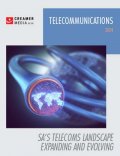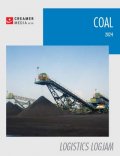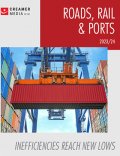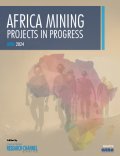|
SELECT a_id, a_id_word, a_headline, a_publish_date, a_abstract, a_author, a_has_video, a_has_audio FROM su_cat_sg_mappings, re_categories , re_category_sections_assoc , pr_sections , pr_article_section_assoc , pr_articles_search, pr_article_media_assoc WHERE csg_sg_id = 1 AND csg_cat_id = cat_id AND a_status = 1
AND a_process_status = 4 AND a_expiry_date >= 1732195800
AND cat_id = scat_cat_id AND scat_s_id = s_id AND s_id = ase_s_id AND ase_a_id = a_id
AND cat_re_id = 42 AND ama_a_id = a_id AND ama_mt_id = 2 AND ama_p_id = ase_p_id AND s_id NOT IN (14903,14910,14911,14906,14904,14912,14909,14908,14907,14905) AND a_publish_date <= 1732195800 AND ase_s_id IN (14576,15076,14885,15075,14270,14271,14272,14886,14274,14273,14888,15674,14887) GROUP BY a_id ORDER BY a_publish_date DESC LIMIT 0, 100
|
 |
Coal – Midyear Brief 2023
 Published: 18 Oct 23
The Coal – Midyear Brief 2023 is a three-page synopsis of key developments in South Africa’s coal sector over the past 12 months. The sector still dominates the country’s energy mix, however, it is no longer economically viable to send coal by road to ports for export.
|
|
 |
Real Economy Yearbook 2023
Published: 01 Sep 23
Loadshedding continues to cast a confidence-sapping pall across South Africa’s real economy, which is lso being weighed down by a series of other infrastructure failures, from water to rail. Focusing on the electricity crisis – which remains the biggest risk to growth and development even though other threats are rising – appears to be yielding some results, albeit insufficient in speed and scale to fully address the crisis.
Nevertheless, there is still a long way to go, with South Africa’s public procurement of new generation continuing to underdeliver.
However, the pressure on the real economy does not start and end with power, or the lack thereof.
Creamer Media’s ‘Real Economy Yearbook 2023’ reflects on the lack of sustainable progress in building capacity in the public sector, the ability of the country to build resilience against further crises, along with South Africa’s appeal as an attractive investment option.
|
Real Economy Yearbook 2023
|
 |
Projects in Progress 2023 (First Edition)
Published: 26 May 23
Creamer Media’s 'Projects in Progress 2023' supplement considers some of the major project developments under way, including high-profile electricity, hydrogen, industry, petrochemicals and gas, as well as water projects in the engineering sector. The supplement also includes some mining projects in the coal, diamonds, gold and platinum sector, as well as a few of the lower-profile public and private developments. What remains apparent is that the private-sector pipeline for projects remains especially weak, owing to poor levels of investor confidence. Nevertheless, project activity is continuing across most of the mining subsectors and in some pockets of industry.
|
|
 |
Battery Metals 2023: Powering the green economy
 Published: 17 May 23
The clean energy transition has unleashed unprecedented demand for key minerals and metals. Lithium, nickel, cobalt, manganese and graphite are crucial to battery performance, longevity and energy density. Rare-earth elements are essential for permanent magnets used in wind turbines and electric vehicle (EV) motors, while copper underpins electricity-related technologies. These so-called critical minerals and metals are considered the building blocks for the green and digital economy, without which there will be no batteries, no EVs, no wind turbines and no solar panels.
Creamer Media’s ‘Battery Metals 2023: Powering the green economy’ report provides an overview of the battery metals market in this context. Globally, the focus of the report is on supply and demand and the creation of a sustainable battery value chain, as well as the environmental and social impact of battery metals production. In Africa, the report’s focus shifts to some of the key mining projects under way on the continent.
|
|
 |
Coal 2023: Phasing down, not phasing out
 Published: 14 Mar 23
Global climate change issues and environmental, social and governance pressures continue to attract significant attention, not least regarding the impact of coal on the environment. Some investors are divesting from companies involved in fossil fuel extraction, including banks and other funding institutions, which are increasingly limiting access to finance for the development of new coal-fired power stations and thermal coal mines. Many governments have pledged to reduce greenhouse-gas emissions under the Paris Agreement to avoid the worst effects of climate change, which is, consequently, impacting on demand for thermal coal.
South Africa is an outlier with regard to its dependence on coal. It is the most coal-dependent country in the Group of 20 major economies. Nonetheless, it has arguably set the most aggressive carbon abatement targets of any developing country. The country's aim in 2010, as per a submission to the United Nations Framework Convention on Climate Change (UNFCCC), was to reduce emissions by 34% below business as usual by 2020 and 42% below business as usual by 2025.
Some, however, argue that only the developed world should decarbonise, allowing South Africa to fuel its growth with coal. South Africa’s Mineral Resources and Energy Minister Gwede Mantashe is opposed to an “accelerated transition” away from coal, despite the concept having recently featured again in a political declaration signed between South Africa and several developed countries, this time at the twenty-sixth Conference of the Parties to the UNFCCC in 2021. He argues that if South Africa were to stop mining, trucking, shipping and burning coal, ten ghost towns would be created. Accepting that this would be a likely eventuality if the transition were to be mismanaged, however, is by now common cause, and outgoing Minerals Council South Africa CEO Roger Baxter has contended “[the] process . . . must be carefully and pragmatically managed so that employees and communities are not worse off”.
Creamer Media’s ‘Coal 2023: Phasing down, not phasing out’ report reflects on the current state of the coal sector, including demand for, and world trade in, coal; and the main participants in South Africa’s coal sector, their projects and some of their initiatives to combat climate change. The report also considers South Africa’s just energy transition, which requires the coal mining sector to be involved.
|
|
 |
Gold 2022/23: Still a safe-haven asset
 Published: 09 Feb 23
Gold continues to be regarded as a good safe-haven asset for investors during difficult and uncertain times.
The World Gold Council contends that 2022 was a textbook example of how gold’s assorted sources of demand and supply can offset one another, “providing gold with its uniquely stable performance as an investment asset”.
In South Africa, once the world’s top producer, the country’s mining industry is facing a deteriorating security environment and a crime crisis that is costing the sector as much as R20-billion a year. While there are bright spots and new investment in productive capacity, ever-increasing electricity tariffs, ongoing and worsening loadshedding, and the need for mining houses to decarbonise their operations remain challenges.
Creamer Media’s ‘Gold 2022/23’ report delves into these issues, looking for instance at the investments that mining companies are making in renewable energy, labour relations and illegal mining, as well as mergers and acquisitions. It also gives an overview of South Africa’s major gold miners, focusing on their financial and operational performance. Finally, the report reflects on the main issues affecting the industry globally, including supply and demand, pricing, and the responsible production and sourcing of gold.
This report is a summary of information published in Engineering News and Mining Weekly, as well as of information available in the public domain over the past 12 months. The report does not purport to provide analysis of market trends.
|
Gold 2022/23: Still a safe-haven asset
|
 |
Energy Transition Report: South Africa Progressing its Just Energy Transition
 Published: 24 Jan 23
International Energy Agency executive director Dr Fatih Birol has said that the world is facing its “first truly global energy crisis”. However, he argues that faster clean energy transitions could help to moderate the impact of the crisis.
South Africa has committed to reducing its greenhouse-gas emissions by 2030 and to achieve net-zero carbon emissions by 2050, subject to appropriate financial support, and premised on enabling a just transition for affected communities and regions.
Government’s Just Energy Transition (JET) Investment Plan outlines investments valued at a combined R1.50-trillion that should be made in the electricity, electric vehicle and green hydrogen sectors over the five years from 2023 to 2027 to enable South Africa to meet its climate commitments, stabilise energy supply and cushion vulnerable workers and communities.
Creamer Media’s “Energy Transition Report 2023” examines South Africa's JET plans by delving into the state of its electricity sector and its current 6 000 MW electricity shortfall; its State-owned power utility Eskom and the challenges it is facing in alleviating that shortfall, and independent power producers that are in the best position to help bridge that shortfall. It also examines South Africa’s potential to produce green hydrogen, and the role that the automotive and mining sectors have to play in fulfilling the country's JET, as well as the capacity that the just transition has to create much-needed employment.
|
|
 |
Iron-Ore 2022: Mixed fortunes
 Published: 06 Dec 22
The re-emergence of Covid-19 curbs in China and a deepening crisis in its real estate sector have been among the factors hindering iron-ore demand growth in 2022.
However, Australian iron-ore producer Fortescue Metals contends that global market conditions remain supportive of iron-ore, as Chinese industrial activity is expected to increase in the coming months. Fortescue Metals also believes that such strong demand for iron-ore will benefit producers amid global supply constraints, owing to the prevailing conflict in Ukraine.
Creamer Media’s ‘Iron-Ore 2022: Mixed fortunes’ report considers the impact of conditions in China and the conflict in Ukraine on the global iron-ore sector, providing an overview of the sector, including efforts to decarbonise. This includes the major global and South African iron-ore producers’ response in the current environment.
|
Iron-Ore 2022: Mixed fortunes
|
 |
Africa Mining Projects in Progress 2022
 Published: 25 Nov 22
South African Mineral Resources and Energy Minister Gwede Mantashe has proclaimed mining is still a sunrise industry on the African continent and has urged investors to come to Africa, because “That’s where the future is!”
However, many investors are finding it difficult to heed the Minister’s call largely owing to the countless, sometimes insurmountable, barriers that prevent many of them from even getting past the initial stages of exploration. As a result, the extent of Africa’s purported mineral wealth remains unknown.
|
|
 |
Projects in Progress 2022 (Second Edition)
Published: 13 Oct 22
Without basic infrastructure to deliver energy and water, and to facilitate mobility and communication, South Africa’s growth prospects will remain constrained.
Greenfield and brownfield investment will also not materialise at the pace and scale needed to stimulate the mass employment required to begin addressing the country’s social scourges.
While the costs of these backlogs are mounting, some optimism can be drawn from the fact that, from energy and transport to digital communications, government and its State-owned enterprises are moving in a direction that will open some of these sectors to new investors.
If well managed, it is even possible that these partnerships could result in a private, fixed investment boom and that the infrastructure required to
stimulate future productive investment will begin to materialise.
|
|
|
|
 Buy Report
Telecommunications 2024: SA's telecoms landscape expanding and evolving
Buy Report
Buy Report
Telecommunications 2024: SA's telecoms landscape expanding and evolving
Buy Report
 Buy Report
Coal 2024: Logistics logjam
Buy Report
Buy Report
Coal 2024: Logistics logjam
Buy Report
 Buy Report
Just Energy Transition 2024: Investing in the future
Buy Report
Buy Report
Just Energy Transition 2024: Investing in the future
Buy Report
 Buy Report
Hydrogen 2024: Implementation crucial going forward
Buy Report
Buy Report
Hydrogen 2024: Implementation crucial going forward
Buy Report
 Buy Report
Roads, Rail & Ports 2024: Inefficiencies reach new lows
Buy Report
Buy Report
Roads, Rail & Ports 2024: Inefficiencies reach new lows
Buy Report
 Buy Report
Africa Mining Projects in Progress 2024
Buy Report
Buy Report
Africa Mining Projects in Progress 2024
Buy Report
 Key Ridge and Hammarsdale upgrade project, South Africa
Published: 15 Nov 24
Key Ridge and Hammarsdale upgrade project, South Africa
Published: 15 Nov 24
 Port of Mossel Bay’s Quay 4 precinct multipurpose terminal, South Africa
Published: 15 Nov 24
Port of Mossel Bay’s Quay 4 precinct multipurpose terminal, South Africa
Published: 15 Nov 24
 Southern region road infrastructure build programme, South Africa
Published: 15 Nov 24
Southern region road infrastructure build programme, South Africa
Published: 15 Nov 24
 Gold and copper miner Evolution Mining founder and chairperson Jake Klein has called for a clear strategy to future-proof Australia’s mining...
AgriSA says agriculture’s ability to reduce emissions recognised at COP29
Published: 21 Nov 24
Gold and copper miner Evolution Mining founder and chairperson Jake Klein has called for a clear strategy to future-proof Australia’s mining...
AgriSA says agriculture’s ability to reduce emissions recognised at COP29
Published: 21 Nov 24
 With the COP29 conference under way until November 22, industry body AgriSA says the global climate change agenda is increasingly recognising the...
Hulamin improves product quality with new hot-edge inductors from Primetals
Published: 21 Nov 24
With the COP29 conference under way until November 22, industry body AgriSA says the global climate change agenda is increasingly recognising the...
Hulamin improves product quality with new hot-edge inductors from Primetals
Published: 21 Nov 24
 Engineering and plant construction company Primetals Technologies has recently signed the final acceptance certificate with aluminium producer...
Engineering and plant construction company Primetals Technologies has recently signed the final acceptance certificate with aluminium producer...
 Gold and copper miner Evolution Mining founder and chairperson Jake Klein has called for a clear strategy to future-proof Australia’s mining...
AgriSA says agriculture’s ability to reduce emissions recognised at COP29
Published: 21 Nov 24
Gold and copper miner Evolution Mining founder and chairperson Jake Klein has called for a clear strategy to future-proof Australia’s mining...
AgriSA says agriculture’s ability to reduce emissions recognised at COP29
Published: 21 Nov 24
 With the COP29 conference under way until November 22, industry body AgriSA says the global climate change agenda is increasingly recognising the...
Hulamin improves product quality with new hot-edge inductors from Primetals
Published: 21 Nov 24
With the COP29 conference under way until November 22, industry body AgriSA says the global climate change agenda is increasingly recognising the...
Hulamin improves product quality with new hot-edge inductors from Primetals
Published: 21 Nov 24
 Engineering and plant construction company Primetals Technologies has recently signed the final acceptance certificate with aluminium producer...
Engineering and plant construction company Primetals Technologies has recently signed the final acceptance certificate with aluminium producer...


















